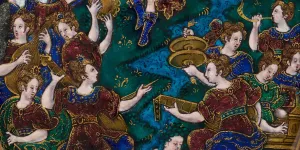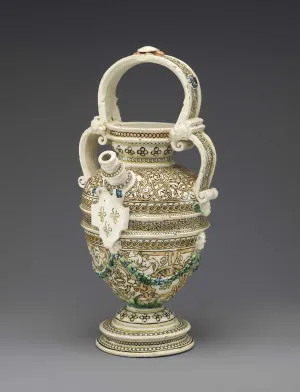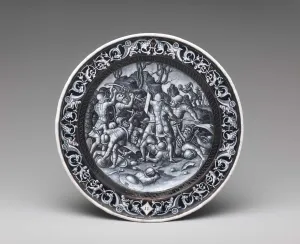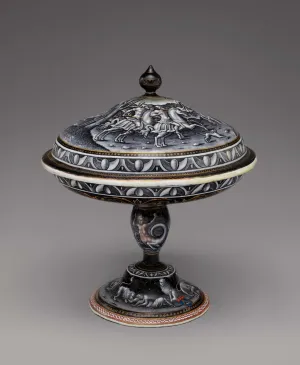Audio
Saint-Porchaire Ware
Ewer (Biberon)
Mid-16th century
Lead-glazed earthenware
10 1/4 × 5 1/16 × 5 1/16 in. (26 × 12.9 × 12.9 cm)
Gift of Alexis Gregory, 2020
Photo Joseph Coscia Jr.
Part of a very small, luxurious production created during the reign of King Henry II of France (r. 1547–59), this three-handled ewer, or biberon (nursing bottle), has a complex molded, stamped, and inlaid decoration consisting of foliage, leaves, cabochons, and leonine masks. The delicate interlacing forms several intricate patterns, and a strapwork cartouche features a coat of arms made up of three fleurs-de-lys.
Pierre Reymond ( 1513–after 1584)
Dish: Jason Confronting the Giants
Limoges, mid-16th century
Enamel on copper, parcel-gilt
Diam. 8 in. (20.3 cm); d. 9/16 in. (1.4 cm)
Gift of Alexis Gregory, 2021
Photo Joseph Coscia Jr.
The scenes on these dishes are taken from engravings by René Boyvin (ca. 1525–ca. 1625) after Léonard Thiry (ca. 1500–1550). The other dish shows Jason fighting the dragon, guarding the Golden Fleece, with a sword as the Argonauts watch. At the back, the arms of the Mesmes de Ravignon family impaled with the arms of the Dolu family are flanked by allegories of Air and Earth. This dish depicts Jason confronting the Giants after sowing the teeth of Cadmus’s dragon, one of the tasks he needed to complete to obtain the Golden Fleece.
Pierre Reymond (1513–after 1584)
Dish: Jason Confronting the Dragon Guarding the Golden Fleece
Limoges, mid-16th century
Enamel on copper, parcel-gilt
Diam. 7 15/16 in. (20.2 cm); d. 7/8 in. (2.2 cm)
Gift of Alexis Gregory, 2021
Photo Joseph Coscia Jr.
The scenes on these dishes are taken from engravings by René Boyvin (ca. 1525–ca. 1625) after Léonard Thiry (ca. 1500–1550). This dish shows Jason fighting the dragon, guarding the Golden Fleece, with a sword as the Argonauts watch. At the back, the arms of the Mesmes de Ravignon family impaled with the arms of the Dolu family are flanked by allegories of Air and Earth. The other dish depicts Jason confronting the Giants after sowing the teeth of Cadmus’s dragon, one of the tasks he needed to complete to obtain the Golden Fleece.
Pierre Reymond (1513–after 1584)
Covered Tazza (One of a Pair)
Limoges, ca. 1566
Enamel on copper, parcel-gilt
H. 8 1/2 in. (21.6 cm); diam. 7 1/4 in. (18.4 cm)
Marks (inside the bowl): P.R.
Gift of Alexis Gregory, 2021
Photo Joseph Coscia Jr.
These tazzas are part of a larger service with arms generally attributed to Pierre Séguier (1504–1580) or one of his relatives. The iconography derives from woodcuts by Bernard Salomon (ca. 1508 or 1510–ca. 1561) that illustrates Les Quadrins historiques de la Bible, first published in 1553. The coats of arms represented are similar to those of the Séguier family, but several elements represented here could suggest the Chabriant de Cornac family. The first tazza, inscribed with Exodus XVI, depicts the Fall of Manna.
Pierre Reymond (1513–after 1584)
Covered Tazza (One of a Pair)
Limoges, ca. 1566
Enamel on copper, parcel-gilt
H. 8 1/2 in. (21.6 cm); diam. 7 1/4 in. (18.4 cm)
Marks (inside the bowl): P.R.
Gift of Alexis Gregory, 2021
Photo Joseph Coscia Jr.
These tazzas are part of a larger service with arms generally attributed to Pierre Séguier (1504–1580) or one of his relatives. The iconography derives from woodcuts by Bernard Salomon (ca. 1508 or 1510–ca. 1561) that illustrates Les Quadrins historiques de la Bible, first published in 1553. The coats of arms represented are similar to those of the Séguier family, but several elements represented here could suggest the Chabriant de Cornac family. The first tazza, inscribed with Exodus XVI, depicts the Fall of Manna.
Probably South German
Seated Lion Pomander
ca. 1575
Gold, diamonds, rubies, and enamel
2 13/16 × 1 1/4 × 1 7/8 in. (7.1 × 3.2 × 4.8 cm)
Gift of Alexis Gregory, 2021
Photo Joseph Coscia Jr.
Cast in gold and made of six distinctive parts—body, tail, head, collar, crown, and heart—this seated lion has a pelt and a flowing mane richly mounted with cut and faceted diamonds and rubies. The head and collar are set with rubies, diamonds, and black enamel. The chasing creates the effect of fur. The lion clutches a gold heart with diamonds, which bears an Italian inscription that may be a line from a poem: Che.gire.ancor qu.i.s.oggi orna (Here the heart adorns itself today so as to keep beating).
Suzanne de Court (act. ca. 1600)
Oval Medallion: Apollo and the Muses
Limoges, ca. 1600
Enamel on copper, parcel-gilt
4 1/4 × 3 1/2 in. (10.8 × 8.9 cm)
Marks (at top of plaque): S.C.
Gift of Alexis Gregory, 2021
Photo Joseph Coscia Jr.
This composition representing Apollo and the Muses on Mount Helicon derives from a print by Giorgio Ghisi (1520–1582) that was made after a drawing by Luca Penni (1500 or 1504–1557). Flanked by a putto and Pegasus, Apollo is playing his lyre on deep green grass. Two bearded men wearing laurel wreaths, perhaps poets, are gesturing in his direction.
Attributed to Domenico Cucci (ca. 1635–1705) and Workshop
Figure of Louis XIV
Manufacture des Gobelins, Paris, 1662–64
Gilt bronze and porphyry
13 5/8 × 11 15/16 × 7 1/16 in. (34.6 × 30.3 × 17.9 cm)
Gift of Alexis Gregory, 2021
Photo Joseph Coscia Jr.
This sculpture, which may have been part of the so-called Cabinet of Apollo made after designs by Charles Le Brun, was among the first works of art produced at the Gobelins for Louis XIV of France (r. 1661–1715). The subjects depicted were intended to celebrate the king’s glory at the close of a lengthy war against Spain. Louis XIV is shown seated on a lion’s pelt—associated with Hercules—wearing armor, and draped in a cloak. He holds a scepter and an Apollo shield, one of his emblems. The upper part of the shield has been partially erased.
James Cox (ca. 1723–1800)
Musical Automaton: Rhinoceros Clock
ca. 1765–72
Gilt bronze, silver, enamel, pearls, and colored glass
Pedestal: white marble and agate
15 9/16 × 8 3/8 × 3 1/2 in. (39.5 × 21.3 × 8.9 cm)
Two enamel dials, one signed JAs Cox London
Gift of Alexis Gregory, 2021
Photo Joseph Coscia Jr.
The “rhinoceros mania” began in Europe when a rhinoceros from India named Miss Clara was brought by the Dutch East India Company to Rotterdam in 1741 and exhibited in several cities until her death in London in 1758. Standing on a white marble pedestal and carrying a musical clock on its back, this rhinoceros figure is modeled after a celebrated print by Albrecht Dürer (1471–1528). The animal supports a small edifice that includes a clock and jeweled flowers.









